The Battle of Cornuda
The liberation of Cornuda
The “battle of Cornuda” (as it is remembered in the documents) is reported by many different official sources. The fightings happened in the 30 April 1945 and in the night between the 30 April and the 1 May are remembered as some of the most violent episodes occurred during the last days of the war.
The sources that describe this episode from me used are:
Klaus H. Huebner, “Long Walk through War”, Texas A&M, 1987.
James C. Fry, “Combat Soldier”, the National Press, Inc., 1968.
John P. Delaney, “The Blue Devils in Italy”, Battery Press, 1988.
John E. Wallace, “The Blue Devil Battle Mountain Regiment in Italy”, Battery Press, 1977.
“History of the 349th Infantry Regiment”, 88th Infantry Division Association Inc., 1973.
Official reports of the 349th regiment, Us National Archives.
Memories and pictures kept in Cornuda’s Town Library.
Combat film “the battle for Cornuda”, Us National Archives, Washington D.C.
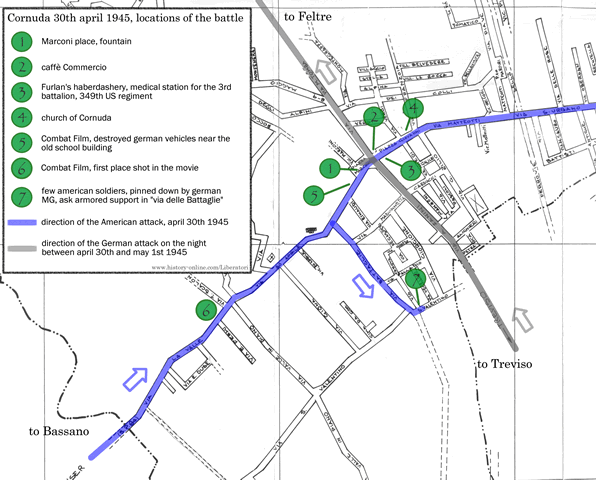
battle of Cornuda
While the 350th regiment defended the road from Vicenza to Bassano, the 351st regiment advanced toward north from Bassano while the 349th regiment advanced toward Cornuda, with elements of the 752nd Tank Battalion and the 805th Tank Battalion Destroyer as support.
The spearhead of the column was formed by a combined task force of armoured units followed by infantrymen, guided by the Colonel James C. Fry, already commander of the 350th regiment and in that period promoted as commander assistant of the 88th division. The 349th regiment, 88th division “Blue Devils”, commanded by Colonel Sturgeon, marched with the 2nd battalion in head, followed by the 1st and finally by the 3rd battalion.
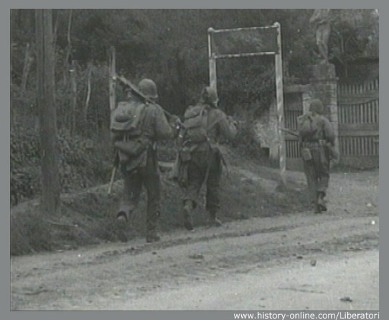
scenes from the combat film
The column was protected by close air support, which punctually informed about the positions assumed by the Germans. Different german defence blocks, placed to slow down the advance, were overrun along the road.
Testimonies of these days remember the presence of an airplane, probably a Piper Cub reconaissance aircraft, hovering over Cornuda during the afternoon. This type of aircraft was usually confused with the “Storch”, common name of the German reconaissance aircraft, similar to the Cub for its purpose and dimension.
American forces reached Cornuda in the first afternoon along the via la Valle street and via Littorio street, further called via 30 Aprile in memory of that day, engaging in a bitter fight against hundreds of German soldiers located in town. Tanks used suppression fire against some houses to flush out small units of hardened soldiers.
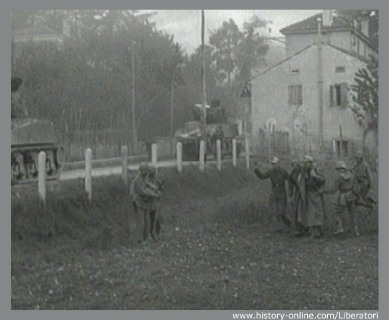
M-4 on street 30 aprile
Some American soldiers were blocked in a building of via delle Battaglie street, surprised by the fire of a German machine gun nest preventing them to move. An American tank left the column to help them and run across Via delle Battaglie street, suppressing the German position . The road was so narrow that the tank damaged the walls of some houses.
After few hours of fightings, German forces surrendered to the Allied, understanding the impossibility to sustain a prolonged opposition, and the Americans captured around 200 enemy soldiers. Various German soldiers remained on the ground while the American losses were light.
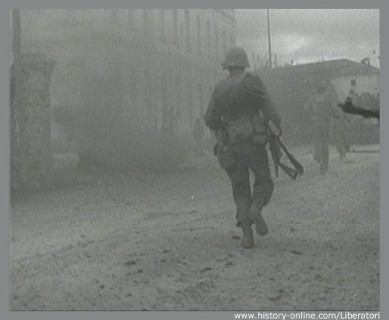
With the arrival in the town of the 349th regiment a group of American soldiers from the 91st division were released, kept imprisoned by the Germans in a two-storey house in town. According to Colonel James C. Fry memories these soldiers expressed the conviction that their jailers were about to kill them, when an American tank smashed the wall of the house garden, routing the German soldiers.
The established goal had been reached, and the unit received the order to continue toward Feltre, even if the day was at the end. The 3rd battalion, last in column, remained at Cornuda’s defence. Armored vehicles and antitank guns were positioned to guard every access to the town that, by its position at the cross of roads along the NS/EW directrix, was a strategic point through which hundreds of Germans had passed in the preceding days, directed to the north.
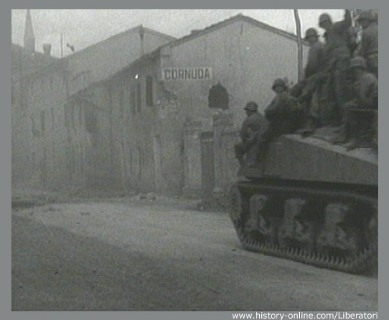
M-4 approaching San Marco plaza
The medic officer of the 3rd battalion, Klaus Huebner, American citizen, but of German origins, established his own medical station in the Furlan’s haberdashery shop, situated at the main crossroads of the town and in front of the Munari Park.
The partisan Alessandro Zanini was killed in a fight during an action against a group of Germans along the Via Feltrina street, the road that lead toward south, not too far from the town center. To Alessandro Zanini was later conferred a gold medal for the valour shown during this episode.
The night fighting
That Cornuda’s liberation was concluded soon revealed as a true illusion. In fact the situation unexpectedly came to a head.
Between 23:00 and midnight on 30 April the situation became a living hell. A whole battalion of Germans, around 600 soldiers, tried to enter in to the town from the south. A scounting German company advanced up to the center of the town: in the dark of the night the American soldiers didn’t immediately realize what happened. In addition, the Germans seemed to ignore the presence of an American detachment, but they were ready to fight.
When a horse wagon arrived in Piazza Marconi square to water itself, an American soldier understood that something was wrong. Probably it was a matter of few second to understand that it dealt with Germans: the Americans didn’t use in fact horses neither spiked boots, whose unmistakable noise played against the silence. The reaction was rapid and all the American units quartered in the buildings of the town and along the roads opened the fire against the German battalion. The Germans attacked more violently the K Company of the 3rd battalion, 349th regiment, positioned on the south side of the town, so much to breach the defence lines and to reach the command post of the company, forcing the American soldiers to retreat toward the town center. The Germans took possession of 4 machine guns and of an antitank gun that they turned to bombard the buildings occupied by the Americans.
The German attack was so determined that the battalion’s command post, positioned in the center of the town, was directly attacked. Captain Ted Bellmont killed with his own pistol a German soldier that was about to storm in the command post. The fight raged, with the German soldiers storming the American positions, launching grenades (called “potato masher” for their look) through the buildings windows and using bazookas against the ground floors.
Klaus Huebner, the medic of the battalion, entrenched himself in his medical station in the shop, opening only to attend to the wounded. Various bullets struck his position.
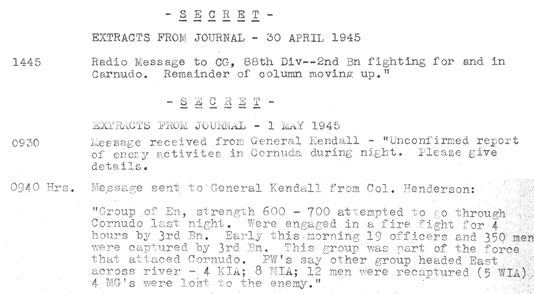
349th regiment command communications
Reports of the 349th regiment command communications regarding Cornuda: the radio message tells the beginning of the clashes for Cornuda’s liberation and the communications between the regiment’s and division command about the fights happened during the night.
The hand to hand fight lasted few hours. At the end, the main part of the German battalion surrendered losing 50 soldiers.
The 3rd battalion of the 349th regiment, 88th division “Blue Devils” lost many soldiers during the defence of Cornuda, while 12 American soldiers were captured by the fleeing Germans. For the rest of the night nobody, among the American soldiers and the citizens of Cornuda, could sleep.
At the early morning, in answer to a information request submitted by the general Kendall, commander of the 88th division, regarding the clashes happened during the night, colonel Henderson, commander of the 349th battalion, declared 8 missing in action and 4 killed in action. Klaus Huebner, medic officer of the battalion and therefore authoritative source for this information, remembers in its memories that 20 American soldiers perished because of the fights in the night.
The day after the battalion, freed Cornuda, moved in the early morning toward Feltre, to join the rest of the American forces and to continue the advance toward north. Before reaching Feltre a group of 300 Germans was captured without a fight, it probably was a group of the battalion escaped after the failed attack to Cornuda of the night before. The 12 American soldiers from the K Company, captured in Cornuda, were freed.
The “Battle of Cornuda” was finished, and the town was free to return to plan a new future.